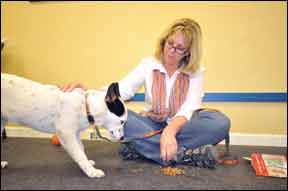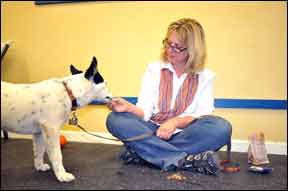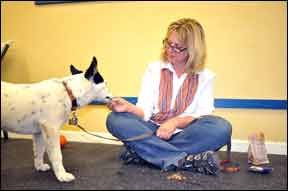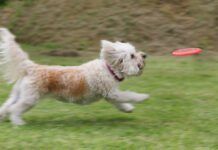This protocol was used with great success to reduce a challenging puppy’s biting and to increase his tolerance for restraint (see the referring article, “How an Intense Behavior Modification Program Saved One Puppy’s Life“). It can be used to help highly fearful or feral dogs learn to accept and enjoy human contact, too.
1. Touch dog’s shoulder with one hand, feed treat with other hand, remove both hands.
2. Repeat multiple times until touch to the shoulder elicits an automatic look for the other hand to arrive with treat.

3. Move touch process to various other parts of dog’s head and body until a touch anywhere on the dog elicits an auto-look for the delivery of a treat. Pay extra attention to any body part where your touch seems to elicit a more intense response from the dog.
4. Start over again at the dog’s shoulder, gradually increasing the duration of touch up to five seconds, feeding bits of treat the entire time. Repeat multiple times, gradually reducing the frequency of treat feeding during the five-second touch.
5. Move the five-second touch process to various other parts of the dog’s body, gradually reducing the frequency of treat feeding at each new touch location.
6. Return to dog’s shoulder, gradually increasing restraint pressure during five-second touch, feeding bits of treat the entire time. Repeat multiple times, gradually reducing the frequency of treat feeding during the five-second touch.

7. Continuing at the dog’s shoulder, gradually increase restraint pressure to ten seconds, feeding bits of treats as necessary to maintain positive association with touch and restraint, and to prevent any mouthing behavior.
8. Move the five-second restraint process to various other parts of the dog’s body, gradually reducing treat-feeding frequency at each new touch location.
9. Gradually increase restraint pressure to 10 seconds at various body part locations, feeding bits of treats as necessary.
10. Randomize touch, restraint, and duration, touching various places in succession, gradually increasing maximum duration of restraint, always feeding bits of treats as necessary to maintain positive association with touch and restraint.






